Where Does Tequila Come From
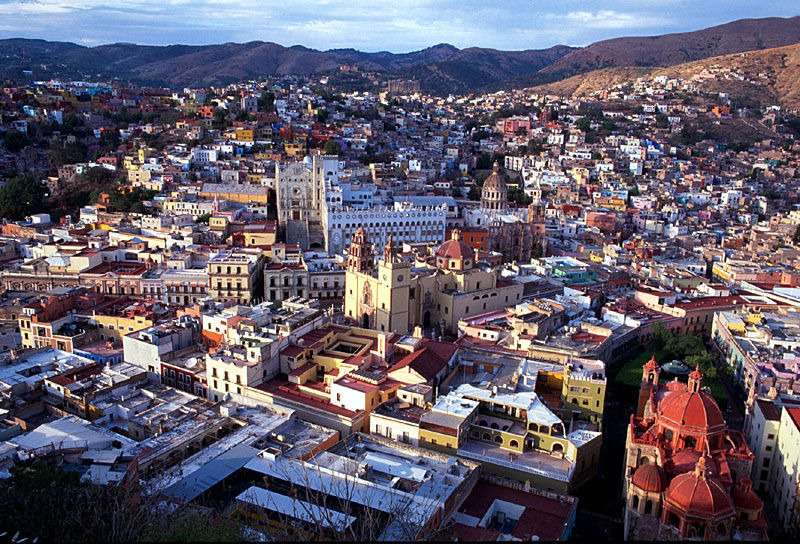 "From Mexico", I hear you say, and that's correct, but how do the Mexicans get the stuff? Well, that question is a little more difficult to answer - that they make it from a cactus is just one of the many myths surrounding Tequila.
In April 2003, my wife participated in the 7th International Symposium on Applied Bioinorganic Chemistry (ISABC7) in the picturesque town of Guanajuato, Mexico, and I accompanied her for a photo trip. I'd like to congratulate the organizers of this conference to a job well done, and for letting me participate in the social events surrounding the conference.
"From Mexico", I hear you say, and that's correct, but how do the Mexicans get the stuff? Well, that question is a little more difficult to answer - that they make it from a cactus is just one of the many myths surrounding Tequila.
In April 2003, my wife participated in the 7th International Symposium on Applied Bioinorganic Chemistry (ISABC7) in the picturesque town of Guanajuato, Mexico, and I accompanied her for a photo trip. I'd like to congratulate the organizers of this conference to a job well done, and for letting me participate in the social events surrounding the conference.
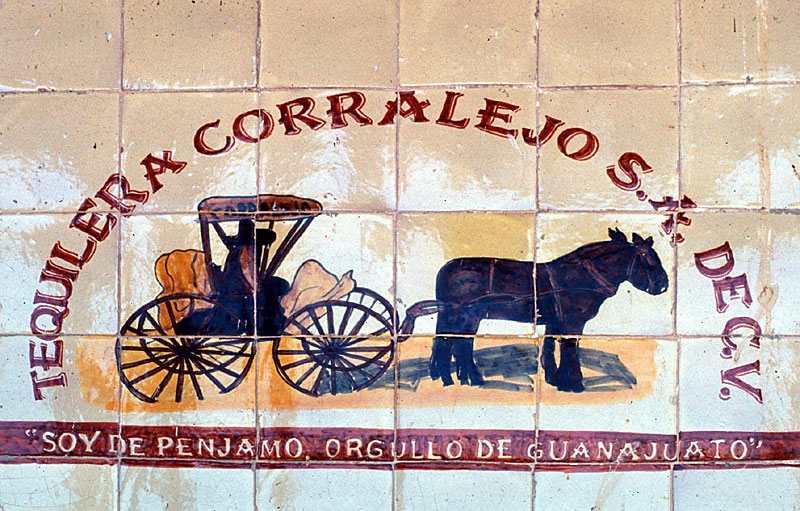 The social highlight of the conference was a visit of the Tequileria Corralejo, which is located in the state of Guanajuato; meaning that is one of only a handful of tequilerias that are not situated in the state of Jalisco - the heartland of tequila production, and home of the town of Tequila that has given the drink it's name. The Tequileria Corralejo is housed on the grounds of the Ex-Hacienda Corralejo, which was founded in 1755, and is claimed to be the first estate in Mexico to produce commerical tequila. According to Ian Chadwick, the modern day tequileria opened it's doors in 1996, but some of their equipment did look a lot older to me, and the methods they are using to produce their award winning tequila appear to be very traditional.
The social highlight of the conference was a visit of the Tequileria Corralejo, which is located in the state of Guanajuato; meaning that is one of only a handful of tequilerias that are not situated in the state of Jalisco - the heartland of tequila production, and home of the town of Tequila that has given the drink it's name. The Tequileria Corralejo is housed on the grounds of the Ex-Hacienda Corralejo, which was founded in 1755, and is claimed to be the first estate in Mexico to produce commerical tequila. According to Ian Chadwick, the modern day tequileria opened it's doors in 1996, but some of their equipment did look a lot older to me, and the methods they are using to produce their award winning tequila appear to be very traditional.
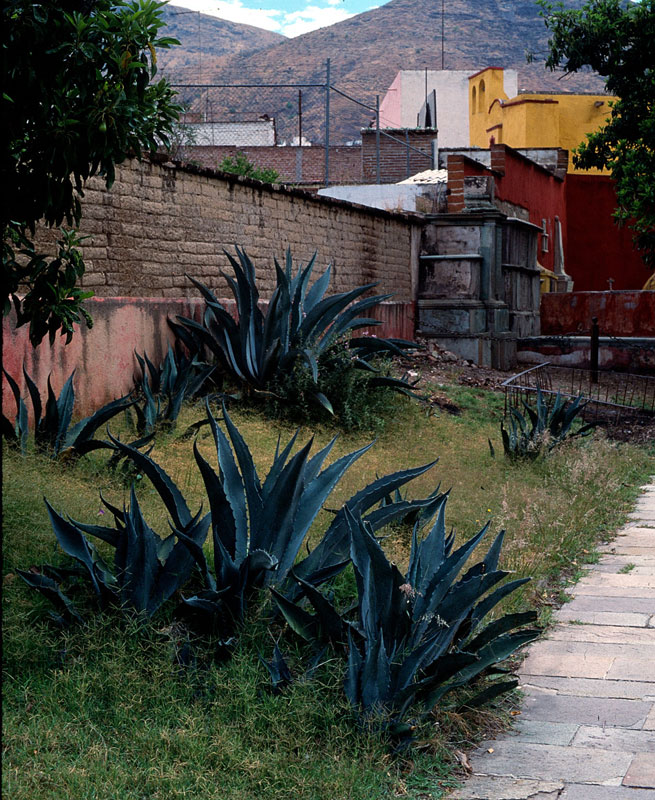 Tequila is made from a plant called Weber Blue Agave (agave tequilana weber azul) that is grown in certain designated areas of Mexico. Agaves are not cacti, but belong to the succulents. Well over a hundred different species of agave grow in Mexico, and my pictures are only meant to show you what an agave looks like. Maybe a botanist in the audience could enlighten us whether or not they show true Weber Blue Agave.
Tequila is made from a plant called Weber Blue Agave (agave tequilana weber azul) that is grown in certain designated areas of Mexico. Agaves are not cacti, but belong to the succulents. Well over a hundred different species of agave grow in Mexico, and my pictures are only meant to show you what an agave looks like. Maybe a botanist in the audience could enlighten us whether or not they show true Weber Blue Agave.
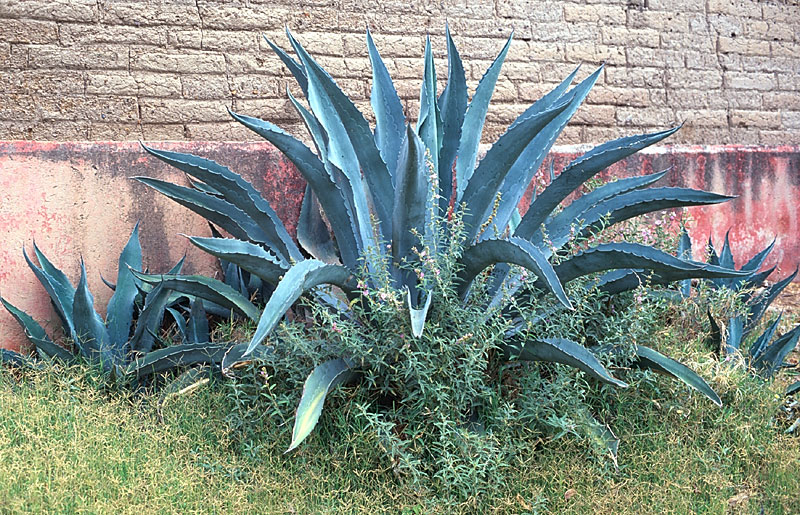 Tequila aficionados make a great fuss over the question whether a tequila is produced 100% from Weber Blue Agave. If this is not the case, the tequila is called a 'mixto' and considered to be of much lesser quality. Corralejo's policy in this regard, according to their own web site in 2003 , is to "use approximately 70% Weber Blue Agave from within the appellation and 30% Blue Agave from more fertile regions of Mexico. For this reason, we choose not to state 100% Agave Azul on our labels, even though our products are made entirely from agave. Our master distiller knows that his unique selection of Agaves for Corralejo produces the very best, true yet mellow tequila." Indeed, Corralejo Tequila is highly regarded among most connoisseurs, and some have expressed their surprise when they found out that Corralejo does not carry the 100% label. Personally I believe it is often overlooked that Corralejo still uses 100% agave - some might just not be of the Weber type or haven't been grown in the designated area - while the typical mixto replaces up to 49% of agave with sugar!
Tequila aficionados make a great fuss over the question whether a tequila is produced 100% from Weber Blue Agave. If this is not the case, the tequila is called a 'mixto' and considered to be of much lesser quality. Corralejo's policy in this regard, according to their own web site in 2003 , is to "use approximately 70% Weber Blue Agave from within the appellation and 30% Blue Agave from more fertile regions of Mexico. For this reason, we choose not to state 100% Agave Azul on our labels, even though our products are made entirely from agave. Our master distiller knows that his unique selection of Agaves for Corralejo produces the very best, true yet mellow tequila." Indeed, Corralejo Tequila is highly regarded among most connoisseurs, and some have expressed their surprise when they found out that Corralejo does not carry the 100% label. Personally I believe it is often overlooked that Corralejo still uses 100% agave - some might just not be of the Weber type or haven't been grown in the designated area - while the typical mixto replaces up to 49% of agave with sugar!
 Admittedly, before my visit at Corralejo, I had tasted tequila only in form of Margaritas, and although I knew that tequila was made from agaves, I had assumed that the outer leaves were cut off and used to make the drink, which would allow them to grow back for another harvest. In reality, the leaves are discarded, and only the core of the agave is used in the tequila production. Thus, a plant which requires 8-12 years to grow to maturity, can only be used once before the farmer has to start over and plant a new crop. The core of the agave is called piña because it resembles a huge pineapple. These piñas are piled up in the yard of the Tequileria Corralejo. The machine on the left is used to quarter large piñas, before they are transferred to the ovens in the background on the right-hand side.
Admittedly, before my visit at Corralejo, I had tasted tequila only in form of Margaritas, and although I knew that tequila was made from agaves, I had assumed that the outer leaves were cut off and used to make the drink, which would allow them to grow back for another harvest. In reality, the leaves are discarded, and only the core of the agave is used in the tequila production. Thus, a plant which requires 8-12 years to grow to maturity, can only be used once before the farmer has to start over and plant a new crop. The core of the agave is called piña because it resembles a huge pineapple. These piñas are piled up in the yard of the Tequileria Corralejo. The machine on the left is used to quarter large piñas, before they are transferred to the ovens in the background on the right-hand side.
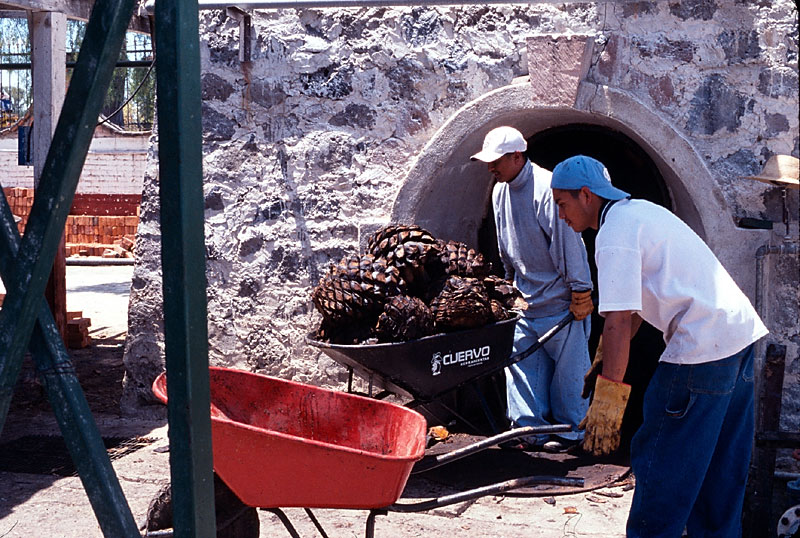 After having been slowly steam-roasted in the ovens, the piñas are taken out and and transferred by wheelbarrow to a shredder. We had the opportunity to sample chunks of the roasted piñas at this stage, and they tasted surprisingly sweet and already showed the delicious tangy-caramel flavor that is characteristic of the final product. Apparently large tequila manufacturers are using steam-injected autoclaves at this point to speed up the process, but no such cutting of corners seems to take place at Corralejo.
After having been slowly steam-roasted in the ovens, the piñas are taken out and and transferred by wheelbarrow to a shredder. We had the opportunity to sample chunks of the roasted piñas at this stage, and they tasted surprisingly sweet and already showed the delicious tangy-caramel flavor that is characteristic of the final product. Apparently large tequila manufacturers are using steam-injected autoclaves at this point to speed up the process, but no such cutting of corners seems to take place at Corralejo.
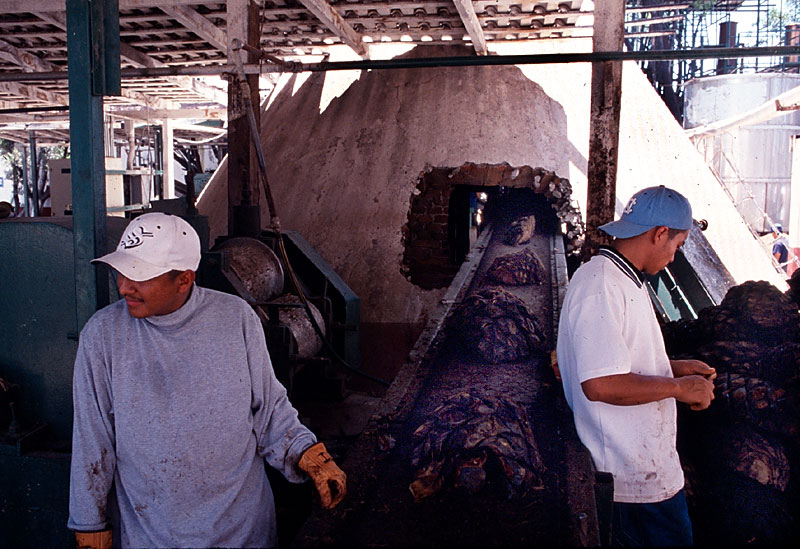 These two workers are loading the roasted piñas onto a conveyor-belt, which will take them through a shredder.
These two workers are loading the roasted piñas onto a conveyor-belt, which will take them through a shredder.
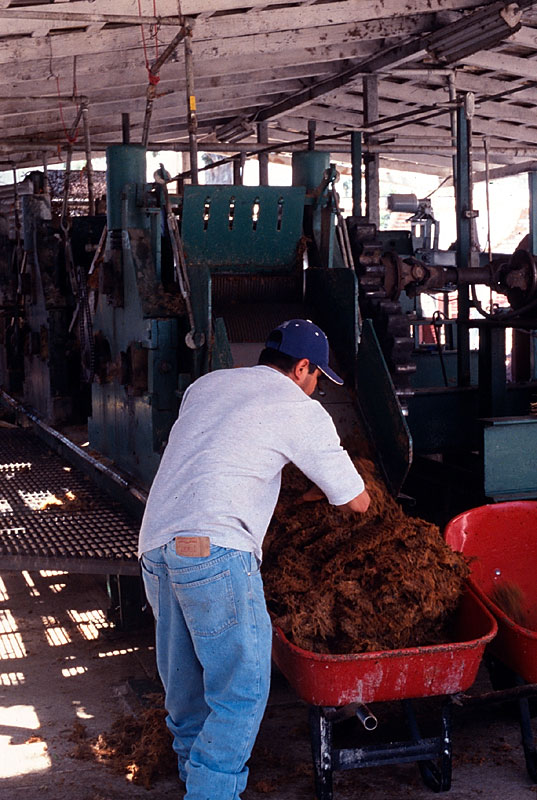 On the other end, the shredded piñas are again loaded into wheelbarrows to be transferred to their next destination.
On the other end, the shredded piñas are again loaded into wheelbarrows to be transferred to their next destination.
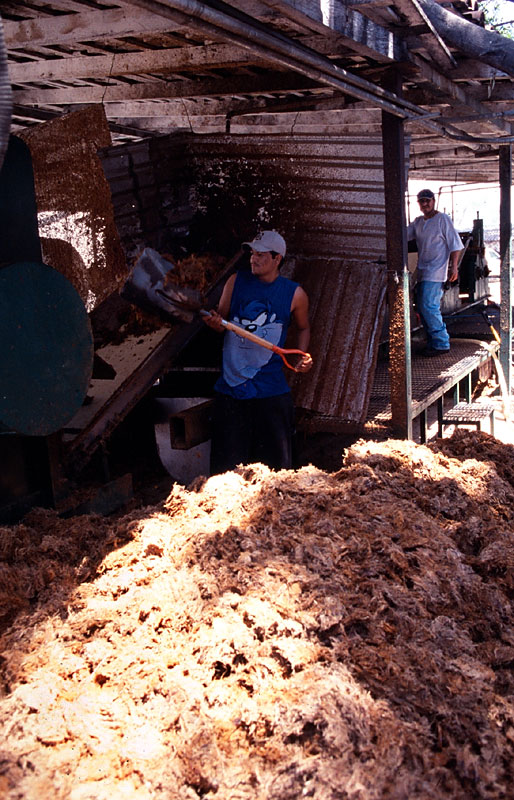 Again, the piñas go onto a conveyor-belt, which takes them into a machine where they are mixed with water and transferred to the fermentation barrels.
Again, the piñas go onto a conveyor-belt, which takes them into a machine where they are mixed with water and transferred to the fermentation barrels.
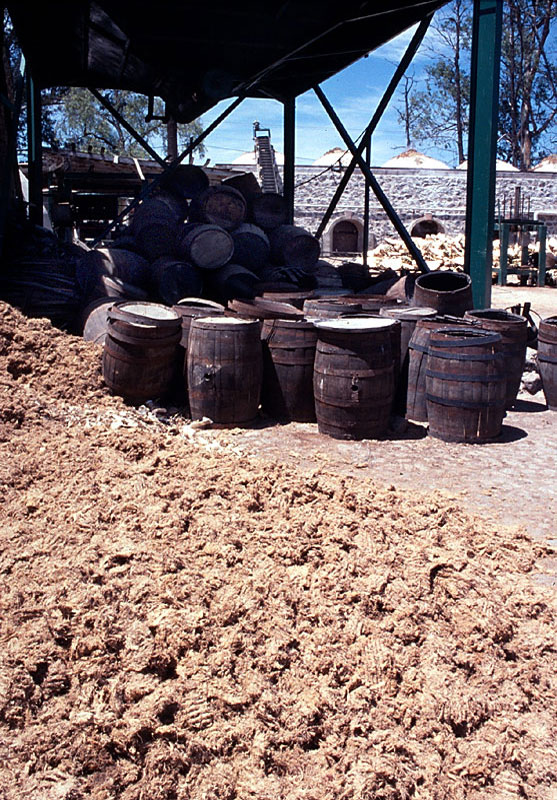 Piles of shredded piñas with some barrels and the roasting ovens in the background.
Piles of shredded piñas with some barrels and the roasting ovens in the background.
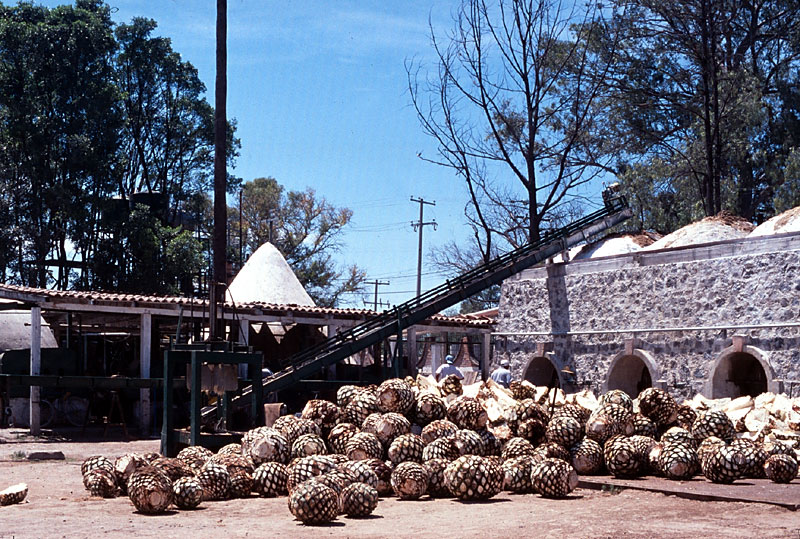 A last look at the yard with lots of piñas in the foreground, the ovens in the background to the right, and to the left various machinery for shredding the piñas and mixing them with water.
A last look at the yard with lots of piñas in the foreground, the ovens in the background to the right, and to the left various machinery for shredding the piñas and mixing them with water.
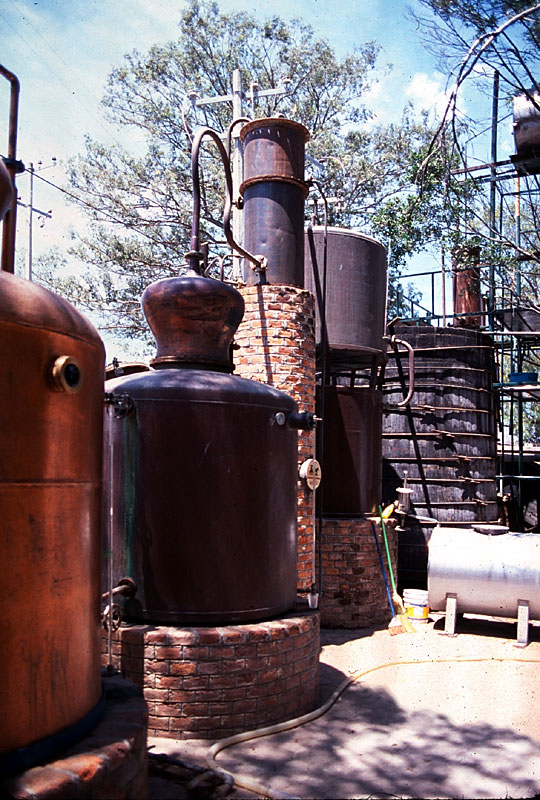 The copper stills of the Tequileria Corralejo. I believe what you can see in the background to the right might be be a wooden fermentation barrel.
The copper stills of the Tequileria Corralejo. I believe what you can see in the background to the right might be be a wooden fermentation barrel.
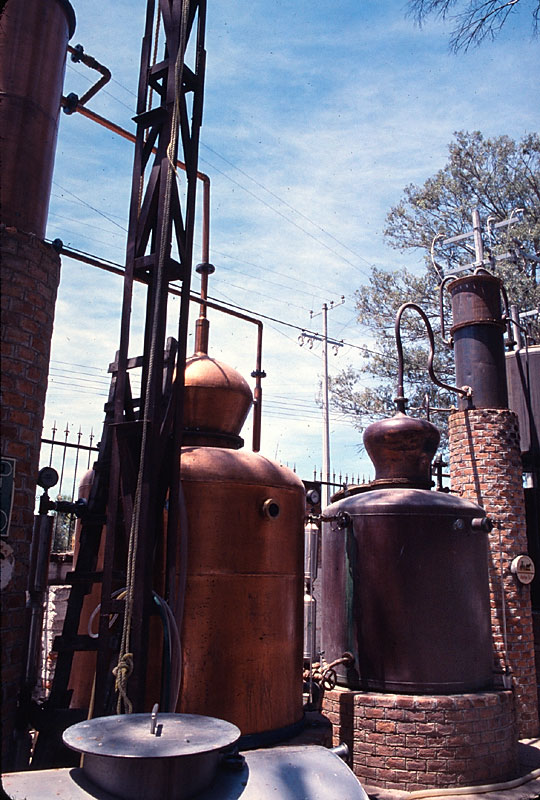 Corralejo Tequila undergoes a double distillation procedure, but recently they are also offering a triple distilled product.
Corralejo Tequila undergoes a double distillation procedure, but recently they are also offering a triple distilled product.
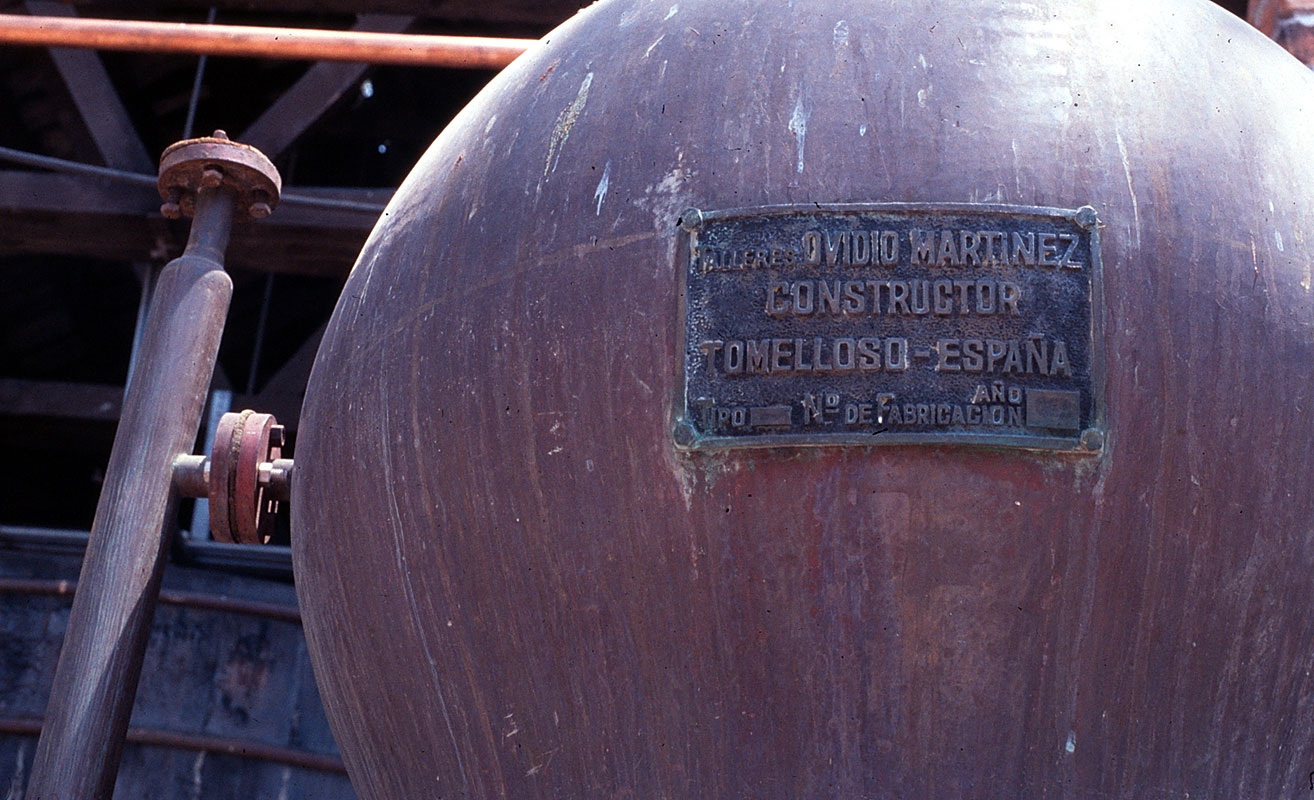 According to Ian Chadwick, the best copper stills are said to come from Tomelloso in Spain, and you can see that at this crucial step of the process, Corralejo does not fall behind the highest expectations.
According to Ian Chadwick, the best copper stills are said to come from Tomelloso in Spain, and you can see that at this crucial step of the process, Corralejo does not fall behind the highest expectations.
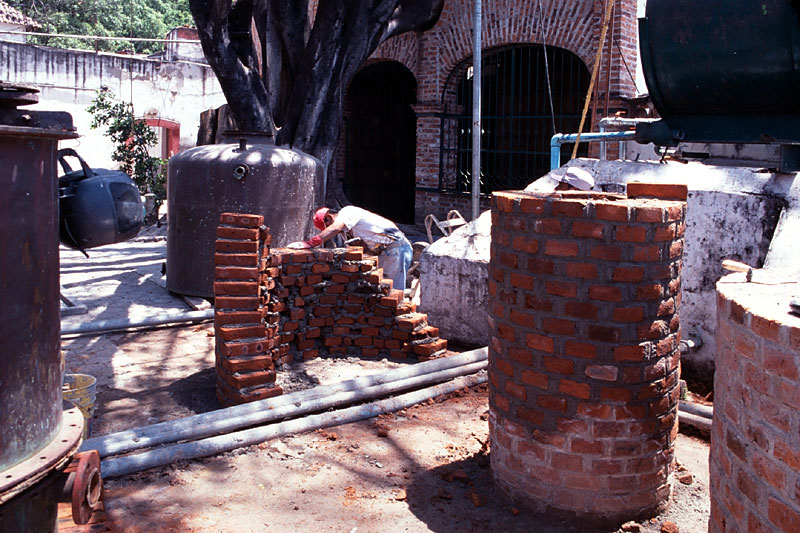 There was some building going on in the tequileria, which seems to indicate that the business is alive and well. Note the boom-box on the left-hand side, which seems to be pretty much compulsory for any Mexican building site!
There was some building going on in the tequileria, which seems to indicate that the business is alive and well. Note the boom-box on the left-hand side, which seems to be pretty much compulsory for any Mexican building site!
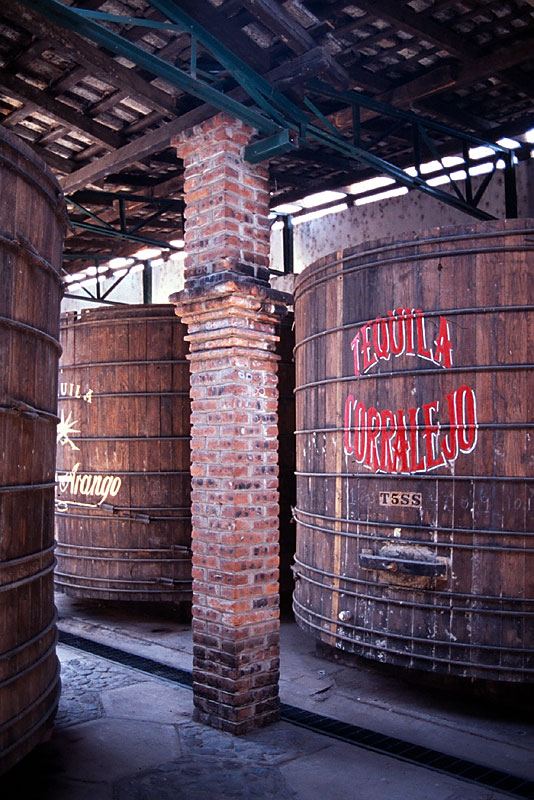 Barrels and barrels full of Corralejo's delicious products! As a general rule, there are three types of tequilas:
Barrels and barrels full of Corralejo's delicious products! As a general rule, there are three types of tequilas:
- Blanco (white) new, un-aged tequila taken straight from the still. Considered the best by some, because aging has not softened the powerful taste of the agave.
- Reposado (rested) has to age in wood barrels for a minimum of two months according to Mexican law. At the time of writing this article in 2003, the Corralejo web site said about their Reposado: "Most of the time we are able to achieve a six month aging for Corralejo Reposado."
- Añejo (year) minimum ageing period of one year. At the time of writing this article in 2003, the Corralejo web site said about their Añejo: "At Corralejo we use only French Oak barrels to produce the softest Añejo tequila
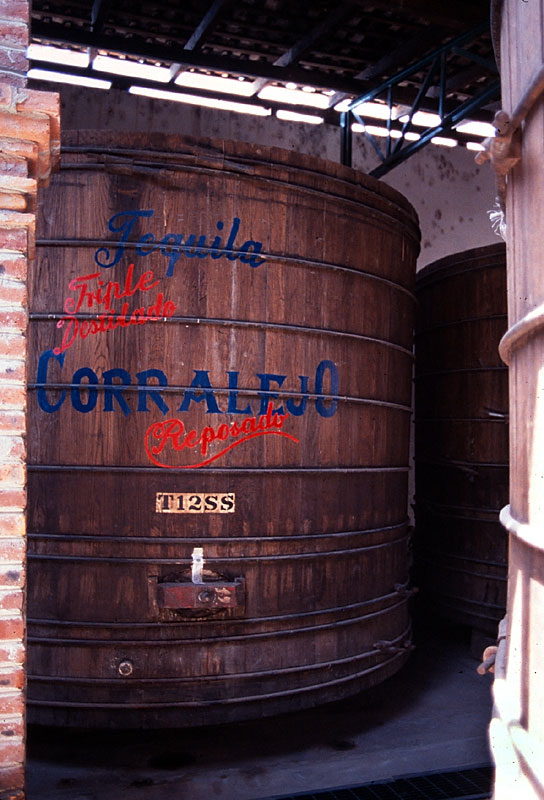 This is one of Corralejo's latest creations - a triple distilled Reposado, which was introduced in 2000 in Mexico, and is slowly finding it's way into export markets. When I wrote this article in 2003 the Corralejo web site said about this product: "Our unique Corralejo 'Triple' is distilled first through a copper pot still, then a column still method and finally through the copper pot one more time." Ian Chadwick doesn't seem to be too enamored with triple distilled tequilas, due to the potential flavor loss. I saved my bottle for quite some time, and it's an excellent tequila, but actually not quite as good as Corralejo's regular Reposado, in my opinion.
This is one of Corralejo's latest creations - a triple distilled Reposado, which was introduced in 2000 in Mexico, and is slowly finding it's way into export markets. When I wrote this article in 2003 the Corralejo web site said about this product: "Our unique Corralejo 'Triple' is distilled first through a copper pot still, then a column still method and finally through the copper pot one more time." Ian Chadwick doesn't seem to be too enamored with triple distilled tequilas, due to the potential flavor loss. I saved my bottle for quite some time, and it's an excellent tequila, but actually not quite as good as Corralejo's regular Reposado, in my opinion.
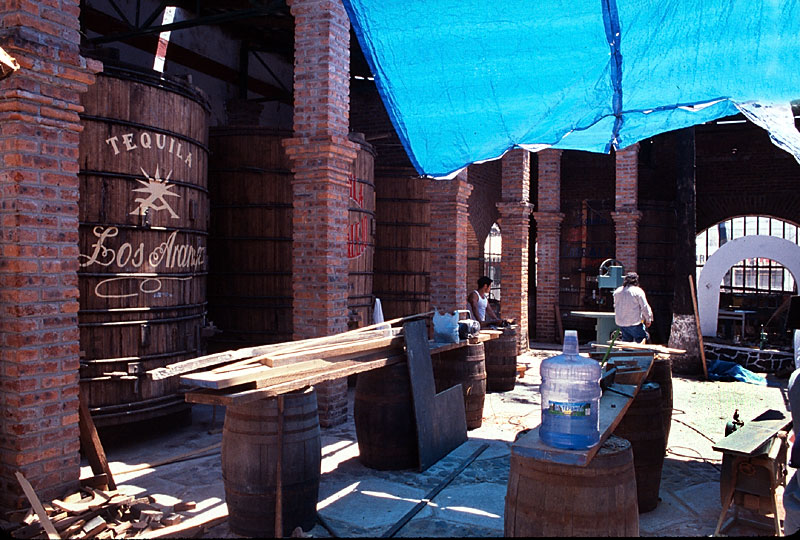 Corralejo's wood workshop is right in between the storage barrels. I was very surprised that virtually all work in the Tequileria is conducted out in the open air. Coming from Germany, I expected to find dark factory halls - which by the way explains my film choice of ISO400 slide film (Fuji Sensia 400) for this project. I guess the weather in Mexico only calls for shade sails.
Corralejo's wood workshop is right in between the storage barrels. I was very surprised that virtually all work in the Tequileria is conducted out in the open air. Coming from Germany, I expected to find dark factory halls - which by the way explains my film choice of ISO400 slide film (Fuji Sensia 400) for this project. I guess the weather in Mexico only calls for shade sails.
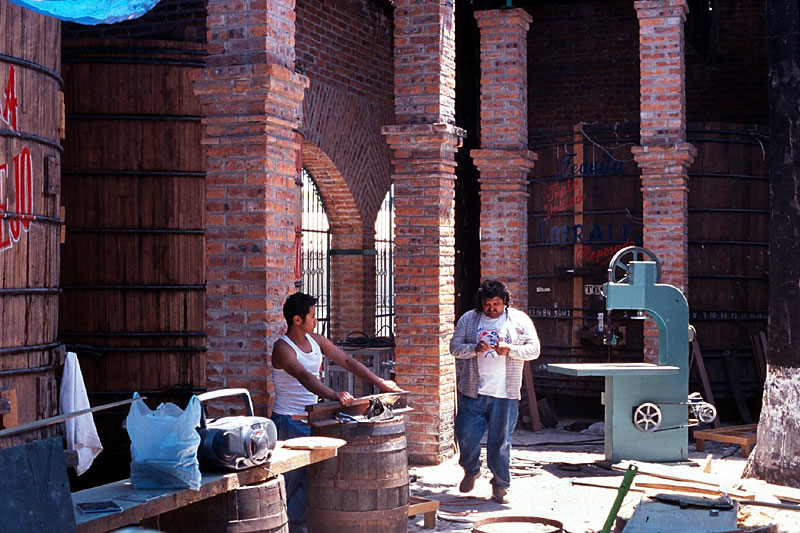 Another picture of the wood workshop. Note the boom-box 😉
Another picture of the wood workshop. Note the boom-box 😉
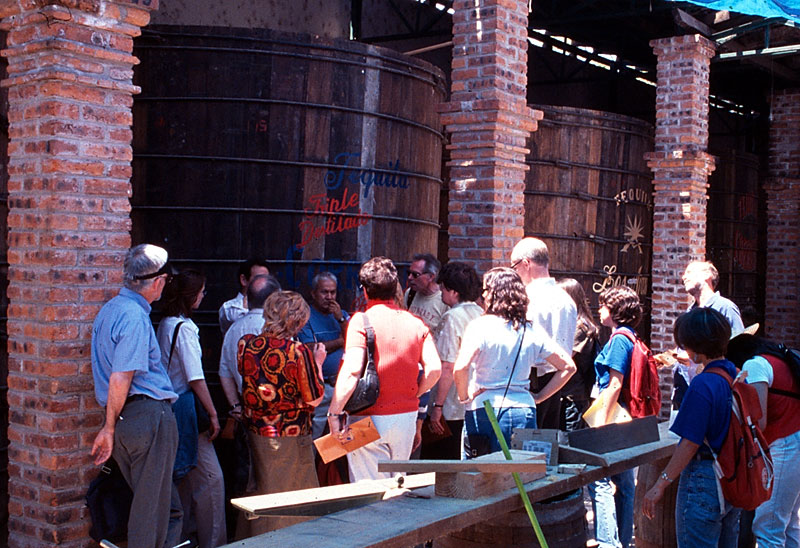 This is our tour group. The gentleman at the back in the middle facing the camera is the representative of Corralejo who was kind enough to show us around. He seemed as proud of Corralejo's products as knowledgeable about their production. To my shame, I did not make note of his name.
This is our tour group. The gentleman at the back in the middle facing the camera is the representative of Corralejo who was kind enough to show us around. He seemed as proud of Corralejo's products as knowledgeable about their production. To my shame, I did not make note of his name.
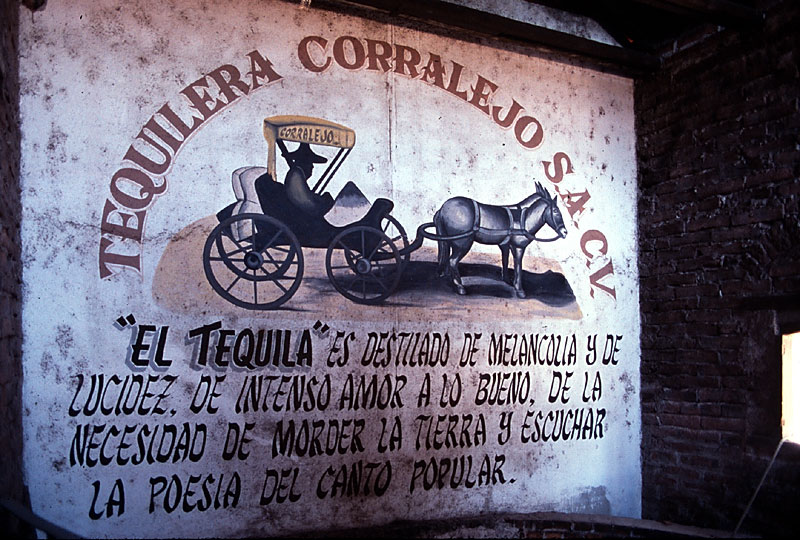 After having seen the whole Tequileria, we were given the opportunity to purchase Corralejo products with lots of expert advice from our hosts. I do not know how easy it would be to visit the Tequileria Corralejo if you are not part of a tour group. However, if you are ever planning to visit that part of Mexico, it would sure be worth checking out. I found it to be a fantastic experience. Also, Corralejo tequilas can be found in good liquor stores throughout the USA, and can be ordered online. A Yahoo or Google search should reveal a distributor near you. Subsequently we were lead to a courtyard were a banquet with the most delicious of Mexican foods had been set up for us. In addition, each of us was presented with a tequila glass to keep, and a small barrel (I am guessing 10 gallons) of Tequila stood ready for each of us to help ourselves to our heart's content. This was the first time I had the opportunity to sip a quality tequila, and it was an experience I would not want to miss!
After having seen the whole Tequileria, we were given the opportunity to purchase Corralejo products with lots of expert advice from our hosts. I do not know how easy it would be to visit the Tequileria Corralejo if you are not part of a tour group. However, if you are ever planning to visit that part of Mexico, it would sure be worth checking out. I found it to be a fantastic experience. Also, Corralejo tequilas can be found in good liquor stores throughout the USA, and can be ordered online. A Yahoo or Google search should reveal a distributor near you. Subsequently we were lead to a courtyard were a banquet with the most delicious of Mexican foods had been set up for us. In addition, each of us was presented with a tequila glass to keep, and a small barrel (I am guessing 10 gallons) of Tequila stood ready for each of us to help ourselves to our heart's content. This was the first time I had the opportunity to sip a quality tequila, and it was an experience I would not want to miss!
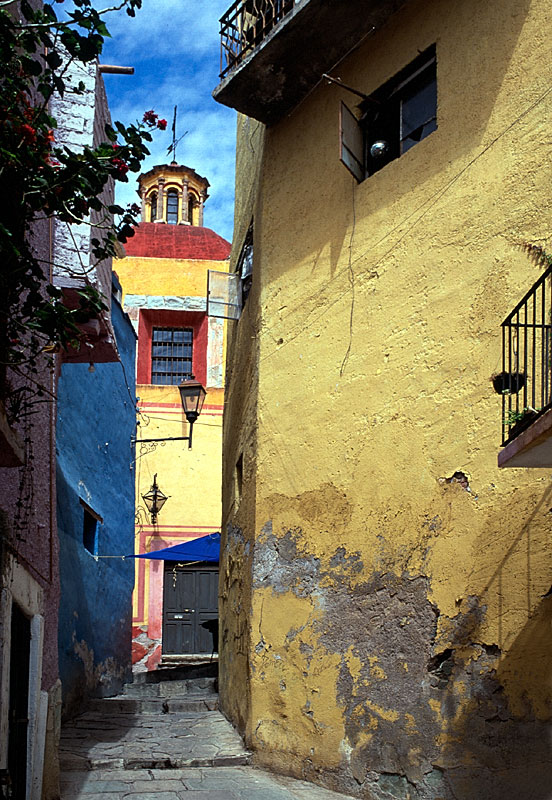 If you would like to see more of the Tequileria Corralejo without leaving your desk, I would recommend visiting the Corralejo web site. When I first updated this article in 2009, the Corralejo web site had been significantly revamped since 2003. I then revisited the site in 2017, and everything including the web address had changed. The business seems to the thriving and doing very well. Overall, in 2017 I could find a lot more info about Corralejo Tequila online than in earlier years, including a number of absolute rave reviews!
If you would like to see more photos of my Mexico trip, please click here.
If you would like to see more of the Tequileria Corralejo without leaving your desk, I would recommend visiting the Corralejo web site. When I first updated this article in 2009, the Corralejo web site had been significantly revamped since 2003. I then revisited the site in 2017, and everything including the web address had changed. The business seems to the thriving and doing very well. Overall, in 2017 I could find a lot more info about Corralejo Tequila online than in earlier years, including a number of absolute rave reviews!
If you would like to see more photos of my Mexico trip, please click here.
Leave a Reply
You must be logged in to post a comment.
